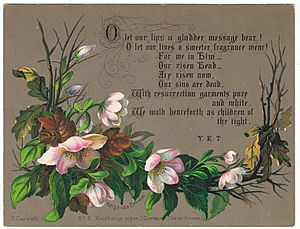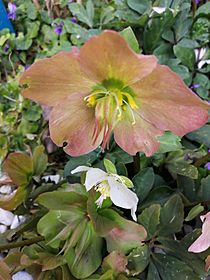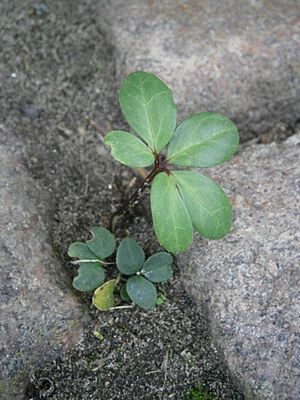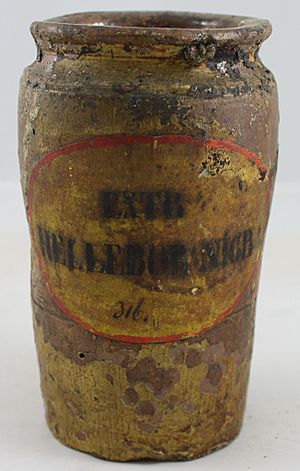Christmas rose facts for kids
Quick facts for kids Christmas rose |
|
|---|---|
 |
|
| Scientific classification | |
| Genus: |
Helleborus
|
| Species: |
niger
|
The Helleborus niger, often called the Christmas rose or black hellebore, is a beautiful evergreen plant. It's a perennial flowering plant that belongs to the buttercup family, called Ranunculaceae. Even though its name includes "rose," it's not actually related to roses.
This plant is known to be poisonous, so it's important not to eat it or touch it without care.
Contents
About the Name
The famous scientist Carl Linnaeus first described the black hellebore in 1753. The second part of its scientific name, niger, is Latin for "black." This might refer to the dark color of its roots.
There are two main types, or subspecies, of H. niger:
- H. niger subsp. niger
- H. niger subsp. macranthus (which has bigger flowers, up to 9 centimeters wide!)
In the wild, you can find H. niger subsp. niger in mountains in places like Switzerland, southern Germany, Austria, Slovenia, Croatia, and northern Italy. The Helleborus niger subsp. macranthus is found only in northern Italy and possibly parts of Slovenia.
What it Looks Like
The Christmas rose is an evergreen plant, meaning its leaves stay green all year. It has dark, leathery leaves that are shaped a bit like a hand with fingers spread out. These leaves grow on stems that are about 23–30 centimeters tall.
Its large, flat flowers appear in the middle of winter and last until early spring. They are usually white, but sometimes they can have a pink tint. The tips of the petals might also be pink or green. In the center of the flower, you'll see a bright cluster of yellow parts.
Growing Christmas Roses
Gardeners love the Christmas rose because it blooms in the coldest part of winter. You can find different types of this plant, including ones with very large flowers, pink flowers, or even flowers with extra layers of petals (called "double-flowered").
The Royal Horticultural Society has given it an Award of Garden Merit (AGM). This award means it's a great plant for gardens and is hardy enough to grow well in the British Isles.
It can be a bit tricky to grow well. It doesn't like acidic soil, or places that are too dry or sunny. It prefers moist, rich soil that is a bit alkaline and gets some shade. Adding leaf-mold can help improve the soil, and lime can be added to make acidic soil more alkaline.
Special Types (Cultivars)
Since the 1950s, a type called 'Potter's Wheel' has been very famous. It started from a special seedling that grew on its own. This seedling had unusually large flowers.
Other special types include:
- 'Potter's Wheel'
- 'Marion' (which has double flowers)
- 'Praecox' (which flowers very early)
Mixed Types (Hybrids)
Plant growers have tried to cross H. niger with other types of hellebores to create new colors. Some successful crosses have been made:
- 'Snow Queen' is a white-flowered plant that appeared in Japan in the late 1990s.
- Helleborus 'Walberton's Rosemary' was created in 2000. It has pink flowers and blooms a lot.
Helleborus niger has also been crossed with other hellebore species.
- Crosses with H. argutifolius are called H. × nigercors. These plants are large and tough, with white flowers that have a green tint. They are great for cut flowers. This hybrid also has an AGM.
- Hybrids with H. × sternii are now called H. × ericsmithii (named after the plantsman who created them). These plants combine the toughness of some hellebores with the large flowers of H. niger and interesting leaf and flower colors. Some types include 'Bob's Best' and 'Ruby Glow'.
- A hybrid with H. lividus is called H. × ballardiae, named after Helen Ballard, who first made this cross.
Poisonous Parts
The Christmas rose contains substances like protoanemonin. These can cause a burning feeling if they get in your eyes, mouth, or throat. If eaten, they can cause stomach upset and other problems. It's important to remember that this plant is poisonous.
Old Stories and Uses
The Helleborus niger is often called the Christmas rose because of an old story. The legend says that it grew in the snow from the tears of a young girl. She was sad because she had no gift to give the Christ child in Bethlehem.
Another old story says the flower blooms at an abbey in England around January 6th. This date used to be Christmas Day on an older calendar. When the flower didn't bloom on the new Christmas Day in 1588, people thought it was a bad sign. This made England wait a long time to switch to the new calendar.
In the Middle Ages, people believed the flowers could protect them. They would scatter them on their floors to keep away bad influences. They also used them to bless animals and to ward off witches. However, some people also thought witches used the plant in their spells, and that sorcerers could use its powder to become invisible.
In ancient times, doctors used "black hellebore" to treat various illnesses, including mental health issues like sadness, and physical problems like gout. It was also known to be toxic. Early studies suggested it contained very dangerous compounds that could slow the heart and even cause death. However, research in the 1970s showed that the roots of H. niger itself don't contain these specific deadly compounds. It seems that earlier studies might have used mixtures from other, more dangerous hellebore species.
In ancient Greece, the city of Antikyra was famous for its black hellebore. The ancient Greek doctor Hippocrates often prescribed black hellebore as a strong laxative. It was believed to have been introduced by Melampus, who used it to cure madness. About a hundred years later, Theophrastus noted that hellebore also had a calming effect.
See also
 In Spanish: Helleborus niger para niños
In Spanish: Helleborus niger para niños





